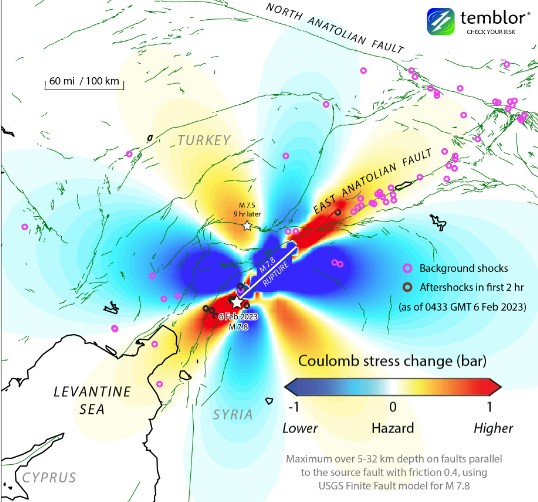Virendra Pandit
New Delhi: With over 5,000 people dying, and many more bodies feared trapped in the rubble of thousands of collapsed buildings and other structures after Monday’s triple earthquakes in Turkey and Syria—the strongest of them was measured at 7.8 on the Richter Scale—India and several other countries rushed relief and rescue teams to the affected areas where relief operations remained sluggish due to inclement weather.
In view of the enormity of the situation, Turkish President Recep Tayyip Erdogan on Monday declared seven days of national emergency and mourning.
Turkiye’s Vice President Fuat Oktay confirmed the deaths of at least 3,419, with another 20,534 people injured. That brought the number of people killed to 5,102, with another 1,602 people confirmed dead on the Syrian side of the border, the media reported on Tuesday.
Rescuers tried frantically to find more survivors but their efforts were being impeded by sub-zero temperatures and some 200 aftershocks, which made the search through unstable structures perilous.
Countries around the world dispatched teams to assist in the rescue efforts, and Turkey’s disaster management agency said more than 24,400 emergency personnel were now on the ground.
Across Hatay province, southwest of the earthquake’s epicenter, officials said over 1,500 buildings were destroyed and many people reported relatives being trapped under the rubble with no aid or rescue teams arriving in time.
The mega-quakes, centered in Turkey’s southeastern province of Kahramanmaras, sent residents of Damascus and Beirut rushing into the street and was felt as far away as Cairo.
The international medical aid organization, Doctors Without Borders, confirmed Tuesday that one of its staff members was among the dead after his house in Syria’s Idlib province collapsed and that others had also lost family members.
Health facilities in northern Syria were overwhelmed with medical personnel working around the clock to respond to the huge numbers of wounded.
In Turkey’s Hatay province, thousands of people sheltered in sports centers or fair halls, while others spent the night outside, huddled in blankets around fires.
In the Turkish city of Gaziantep, a provincial capital about 33 km from the epicenter, people took refuge in shopping malls, stadiums, mosques, and community centers.
At least 3,381 people were killed in 10 Turkish provinces, with over 20,000 injured, according to the latest figures from Turkish authorities on Tuesday.
The death toll in government-held areas of Syria climbed to 769 people, with some 1,450 injured, officials said.
In the country’s rebel-held northwest, groups that operate there said at least 450 people died, with many hundreds injured.
As rescuers looked for survivors among tangles of metal and concrete spread across a vast affected area—including the Syrian region afflicted with a 12-year-long civil war amid a huge refugee crisis—officials feared the death toll could mount in the days ahead.
Several countries, including India’s 100-strong team, have rushed help to Turkey. On Tuesday, South Korean President Yoon Suk Yeol said he was preparing to swiftly dispatch a 60-person search and rescue team as well as medical supplies and 50 soldiers.
Even crisis-ridden Pakistan sent a flight carrying relief supplies and a 50-member search and rescue team early Tuesday and said there will be daily aid flights to Syria and Turkey from Wednesday. Prime Minister Shehbaz Sharif will travel to Ankara on Wednesday to express his condolences and solidarity, officials in Islamabad said.
India has sent two search and rescue teams, including specially trained dogs and medical personnel.
US President Joe Biden called his Turkish counterpart Erdogan to express condolences and offer assistance to the NATO ally. The White House said it was sending search-and-rescue teams to support Turkey’s efforts.
The quake piled more misery on a region that has seen tremendous suffering over the past decade.
On the Syrian side, the earthquake-affected area is divided between government-controlled territory and the country’s last opposition-held enclave, which is surrounded by Russian-backed government forces. Turkey is already home to millions of refugees from the Syrian civil war.
In the rebel-held enclave, hundreds of families remained trapped in the rubble, the opposition emergency organization known as the White Helmets said in a statement.
The area is packed with some four million people displaced from other parts of the country by the long civil war.
Many live in buildings that were already damaged by military bombardments.
Strained medical centers quickly filled with injured people, rescue workers said. According to the SAMS medical organization, some facilities had to be emptied, including a maternity hospital. More than 7,800 people were rescued across 10 provinces.
The seismically-sensitive region sits on top of major fault lines and is frequently shaken by earthquakes. In 1999, nearly 18,000 were killed in similarly powerful earthquakes that hit northwest Turkey.
The US Geological Survey measured the magnitude of Monday’s quake at 7.8, with a depth of 18 km. Hours later, another quake, likely triggered by the first, struck more than 100 km away with 7.5 magnitudes.
The second jolt caused a multi-story apartment building in the Turkish city of Sanliurfa to topple onto the street in a cloud of dust as bystanders screamed, according to video of the scene. A third temblor, measuring 6.0, leveled many more buildings.
Thousands of buildings were reported collapsed in a wide area extending from Syria’s cities of Aleppo and Hama to Turkey’s Diyarbakir, more than 330 km to the northeast.

